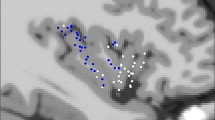Summary
The neurophysiologic substrates of violence and aggression have been extensively studied. Although the EEG is often normal in violent persons any abnormalities are generally nonspecific in nature. Evoked potentials have been infrequently used to study such behavior disorders. Long latency auditory event-related potentials (AEPs) were studied in prison inmates incarcerated for unmotivated violent crimes or violence during the commission of other crimes, and in prisoners jailed for non-violent offenses. Habitually violent inmates were compared with an equal number of non-violent prisoners and neurologically and audiologically intact controls. AEPs were recorded to an “oddball” paradigm from vertex and left and right temporal electrodes. None of the prisoners had latencies more than 3 standard deviations beyond the normal group mean. N1 and P2 components were longer in latency and lower in amplitude in prisoners than in controls, but this was not statistically significant. Violent and non-violent individuals did not differ in these measures. P3 was significantly prolonged in latency in violent inmates, but not in those who had committed a violent act. All components were longer in latency on the right in violent prisoners, while amplitudes were lower but not significantly so. This asymmetry was not present in non-violent prisoners or control subjects. Caution is needed in identifying differences between criminals and the general population, and in seeking markers of violent behavior. These findings may indicate cerebral dysfunction in some perpetrators of antisocial behavior, however, and suggest that evidence of non-dominant cerebral hemisphere dysfunction, possibly subtle and chronic, may be found in some habitually violent individuals.
Similar content being viewed by others
References
Bard T (1928) Diencephalic mechanism for the expression of rage. Am J Physiol 89:490–515
Bell CC (1986–87) Coma and the etiology of violence. J Natl Med Assoc 78:1167–1176;
Bell CC (1986–87) Coma and the etiology of violence. J Natl Med Assoc 79:79–85
Braun BG (1983) Neurophysiologic changes in multiple personality due to integration: A preliminary report. Am J Clin Hypnosis 26:84–92
Cannon PA, Drake ME (1986) EEG and brainstem auditory evoked potentials in brain-injured patients with rage attacks and self injurious behavior. Clin Electroencephalogr 17: 169–172
Cummings JL (1985) Clinical neuropsychiatry. Grune and Stratton, New York, pp 127–129
Donchin E, Ritter W, McCallum WC (1978) Cognitive psychophysiology: The endogenous components of the ERP, in: Calloway E, Tueting P, Koslow SH (eds): Event-related potentials in man. Academic Press, New York, pp 349–411
Drake ME, Burgess RJ, Gelety TJ, Brown ME, Ford CE (1986) Long latency auditory event-related potentials in epilepsy. Clin Electroencephalogr 17:10–13
Elliott FA (1984) The episodic dyscontrol syndrome and aggression. Neurol Clin 2:113–129
Frazier SH (1974) Murder-single and multiple. Res Publ Assoc Nerv Ment Dis 52:304–312
Josef NC, Lycaki H, Chayasirisobhon S (1985) Brainstem auditory evoked potentials in anti-social personality. Clin EEG 16:91–92
Mesulam MM (1981) Dissociative states with abnormal temporal lobe EEG: Multiple personality and the illusion of possession. Arch Neurol 38:176–181
Moyer KE (1968) Kinds of aggression and their physiological basis. Comm Behav Biol A2:65–86
Okada YC, Kaufman L, Williamson SJ (1983) The hippocampal formation as a source of the slow endogenous potentials. Clin Neurophysiol 55:417–426
Pakalnis A, Hietter S, Huber SJ, Drake ME (1988) Effects of carbamazepine and valproate on long-latency auditory event-related potentials. J Epilepsy (in press)
Ross ED, Mesulam MM (1979) Dominant language functions of the right hemisphere? prosody and emotional gestering. Arch Neurol 36:144–148
Ross ED, Harney JH, Delacoste-Utamsing C, Purdy PD (1981) How the brain integrates affective and propositional language into a unified behavioral function: Hypothesis based on clinicoanatomic evidence. Arch Neurol 38:745–748
Tucker DM, Watson RT, Heilman KM (1977) Discrimination and evocation of affectively intoned speech in patients with right parietal disease. Neurology 27:947–950
Weintraub S, Mesulam MM (1983) Developmental learning disabilities of the right hemisphere: Emotional, interpersonal, and cognitive components. Arch Neurol 40: 463–468
Author information
Authors and Affiliations
Rights and permissions
About this article
Cite this article
Drake, M.E., Pakalnis, A., Brown, M.E. et al. Auditory event related potentials in violent and nonviolent prisoners. Eur Arch Psychiatr Neurol Sci 238, 7–10 (1988). https://doi.org/10.1007/BF00381072
Received:
Issue Date:
DOI: https://doi.org/10.1007/BF00381072




